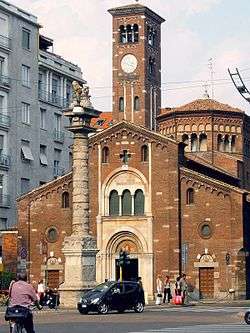San Babila, Milan
| Church of Saint Babylas of Antioch (Chiesa di San Babila) | |
|---|---|
|
Façade of the church | |
| Basic information | |
| Location | Milan, Italy |
| Geographic coordinates | Coordinates: 45°28′01″N 9°11′54″E / 45.467017°N 9.198376°E |
| Affiliation | Roman Catholic |
| Province | Milan |
| Year consecrated | 11c |
| Status | Active |
| Website | Sito ufficiale |
| Architectural description | |
| Architectural type | Church |
| Architectural style | Romanesque Revival |
| Groundbreaking | 11c |
San Babila is a Roman Catholic church in Milan, northern Italy.[1] It was once considered the third most important in the city after the Duomo and the Basilica di Sant'Ambrogio. It is dedicated to saint Babylas of Antioch.
At the beginning of the 5th century, Marolus, the bishop of Milan, brought from Antioch to Milan relics of saints Babylas of Antioch and Romanus of Caesarea. Marolus founded the Basilica Concilia Sanctorum or church of San Romano, which stood until the 19th century, a few meters south of the church of San Babila,[2] on the site of a Roman temple dedicated to the Sun.
The church of San Babila was built on the same site in about 1095.[2] In the 16th century, the church was extended with an additional construction at the front and a new baroque façade. The church still retains its original medieval fabric, although much was lost due to baroque and modern renovations.
The whole complex was renovated in the 19th century with the intent of restoring the appearance of the medieval basilica, and in the early 20th century the Neo-Romanesque façade by Paolo Cesa-Bianchi was built. The bell tower is from 1920, and replaced the original tower which fell down in the 16th century.
The interior has a nave and two aisles. There are two side chapels that date from the late Renaissance. The right aisle has an image of the Madonna which is highly venerated by the Milanese population.
Notes
| Wikimedia Commons has media related to San Babila (Milan). |
- ↑
- 1 2 Tolfo, Maria Grazia. "L'area sacra di Porta Orientale". Storia di Milano. Retrieved 25 Sep 2011.(Italian)
